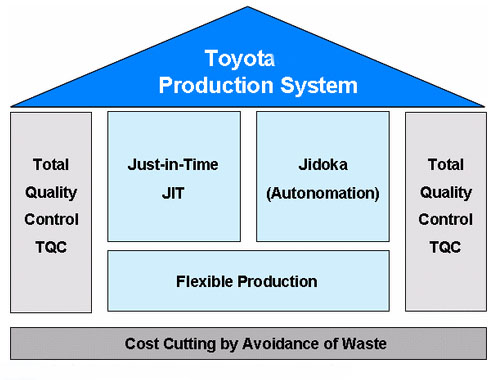
Toyota production system (TPS) is a production system with a central focus on cost management. The person credited with the development of TPS, Mr. Taichi Ohno had stated that the basis of the TPS was the absolute elimination of waste in the system. Ohno came out with his emphasis on waste based on a comparison of productivity per worker in American and Japanese automotive companies. The American productivity was nine times the figure of the Japanese. Ohno reasoned that, American worker was not working nine times more time or nine times more faster than a Japanese worker. There is a lot of waste in the Japanese production systems.

Toyota Production System(TPS)
Two major pillars of TPS are identified as Just-in-Time and Autonomation.
1. Just-in-Time: Just-in-time (JIT) philosophy emerged out of the process of eliminating waste of small batch production system. Small batch production systems are uneconomical because they waste lot of time in set up activities. Hence setup time reduction activities were undertaken, which brought down economic production quantities sharply down. This led to emphasis on quality production. Every item given to the next stage has to be a quality item.
2. Autonomation: Autonomation means automatic machines have intelligence to stop the machine in case there is an abnormality. The concept was extended production lines and production lines stop if there is a problem and they will restart only after the problems is resolved.
These two pillars helped TPS in eliminating waste arising due to production system designs.
Characteristics of Toyota Production System
1. A company-wide industrial engineering activity directly connected with management.
2. Scientific attitude emphasizing facts
3. A practical man-hour reduction activity
4. "Economy in Everything" is the standard of judgment.
5. The workplace is the Boss.
6. Emphasize immediate response to change.
7. The goal is cost reduction.
8. One goal, many approaches. Select the best approach.
9. Make the excess capacity visible.
10. Utilize people and machines effectively.
11. Use the machine that costs less to operate/produce
12. High speed need not mean high economic performance
13. A little waste every day over time adds up.
14. Shorten the lead time.
15. Plan for zero inventory system.
16. Inform planning department of the wastes found.
17. Remain flexible
Integrated Approach of the TPS
Although the cost reduction is the central focus around which the TPS was built, it must achieve three other subgoals in order to achieve its primary objective. They are:
1. Quantity Control: The system has to adapt to daily and monthly fluctuations in demand in terms of quantities and variety and deliver planned output.
2. Quality Assurance: Each process has to supply only good units to the subsequent process.
3. Respect for Humanity: The production system design and operation have to show respect for the human resources that are being used to attain cost objectives.
» More Information 
